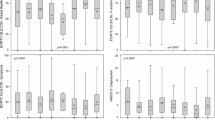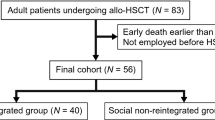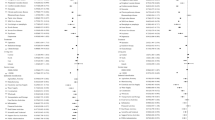Abstract
Return to work (RTW) is a marker of functional recovery in cancer patients, with quality of life, financial and social implications. We investigated frequency and factors associated with RTW in a cohort of patients younger than 66 years, with newly diagnosed multiple myeloma (MM), uniformly treated with a bortezomib-based induction followed by autologous stem cell transplantation (ASCT). Socio-economic and working status data were collected by a self-administered questionnaire. One hundred and eighty-six patients entered the study. Of whom, 145 (78%) where employed at diagnosis, which was more frequent in younger (median 55 vs. 60 years, p < 0.001), men (59.3% vs. 34.2%, p = 0.004), and with college studies (44.8% vs. 24.4%, p = 0.008). Forty-three (30%) of the 145 patients who had a job at diagnosis, RTW after ASCT in a median of 5 (range 1–27) months. Factors independently associated with RTW were having three or more children (HR 2.87, 95% CI 1.33–6.18), college studies (HR 2.78, 95% CI 1.21–6.41), and a family income >40 × 103€/year (HR 2.31, 95% CI 1.12–4.78). In conclusion, the frequency of RTW herein reported in MM patients seems lower than reported in other malignancies. The risk factors observed may guide the design RTW programs.
This is a preview of subscription content, access via your institution
Access options
Subscribe to this journal
Receive 12 print issues and online access
$259.00 per year
only $21.58 per issue
Buy this article
- Purchase on Springer Link
- Instant access to full article PDF
Prices may be subject to local taxes which are calculated during checkout



Similar content being viewed by others
References
Kennedy F, Haslam C, Munir F, Pryce J. Returning to work following cancer: a qualitative exploratory study into the experience of returning to work following cancer. Eur J Cancer Care. 2007;16:17–25.
Désiron HA, Crutzen R, Godderis L, Van Hoof E, de Rijk A. Bridging health care and the workplace: formulation of a return-to-work intervention for breast cancer patients using an intervention mapping approach. J Occup Rehabil. 2016;26:350–65.
Bradley CJ, Brown KL, Haan M, Glasgow RE, Newman LS, Rabin B, et al. Cancer survivorship and employment: intersection of oral agents, changing workforce dynamics, and employers’ perspectives. J Natl Cancer Inst. 2018;110:1292–99.
de Boer AG, Torp S, Popa A, Horsboel T, Zadnik V, Rottenberg Y, et al. Long-term work retention after treatment for cancer: a systematic review and meta-analysis. J Cancer Surviv. 2020;14:135–50.
de Boer AG, Taskila T, Ojajärvi A, van Dijk FJ, Verbeek JH. Cancer survivors and unemployment: a meta-analysis and meta-regression. JAMA. 2009;301:753–62.
Taskila T, de Boer AG, van Dijk FJ, Verbeek JH. Fatigue and its correlates in cancer patients who had returned to work-a cohort study. Psychooncology. 2011;20:1236–41.
Kline RM, Arora NK, Bradley CJ, Brauer ER, Graves DL, Lunsford NB, et al. Long-term survivorship care after cancer treatment—summary of a 2017 National Cancer Policy Forum Workshop. J Natl Cancer Inst. 2018;110:1300–10.
Sharp L, O’Leary E, Kinnear H, Gavin A, Drummond FJ. Cancer-related symptoms predict psychological wellbeing among prostate cancer survivors: results from the PiCTure study. Psychooncology. 2016;25:282–91.
National Cancer Institute. SEER cancer stat facts: myeloma. Bethesda, MD: National Cancer Institute. https://seer.cancer.gov/statfacts/html/mulmy.htm. Accessed Dec 2020.
Alexander DD, Mink PJ, Adami HO, Cole P, Mandel JS, Oken MM, et al. Multiple myeloma: a review of the epidemiologic literature. Int J Cancer. 2012;20:40–61.
Kyle RA, Gertz MA, Witzig TE, Lust JA, Lacy MQ, Dispenzieri A, et al. Review of 1027 patients with newly diagnosed multiple myeloma. Mayo Clin Proc. 2003;78:21–33.
Rosiñol L, Oriol A, Teruel AI, Hernández D, López-Jiménez J, de la Rubia J, et al. Superiority of bortezomib, thalidomide, and dexamethasone (VTD) as induction pretransplantation therapy in multiple myeloma: a randomized phase 3 PETHEMA/GEM study. Blood. 2012;120:1589–96.
Attal M, Lauwers-Cances V, Hulin C, Leleu X, Caillot D, Escoffre M, et al. Lenalidomide, bortezomib, and dexamethasone with transplantation for myeloma. N Engl J Med. 2017;376:1311–20.
Kristinsson S, Anderson W, Landgren O. Improved long-term survival in multiple myeloma up to the age of 80 years. Leukemia. 2014;28:1346–8.
Blimark CH, Turesson I, Genell A, Ahlbert L, Björkstrand, Carlson K, et al. Outcome and survival of myeloma patients diagnosed 2008–15. Real-world data on 4904 patients from the Swedish Myeloma Registry. Haematologica. 2018;103:506–13.
Langseth ØO, Myklebust TÅ, Johannesen TB, Hjertner Ø, Waage A. Incidence and survival of multiple myeloma: a population-based study of 10 524 patients diagnosed 1982–2017. Br J Haematol. 2020;191:418–25.
Costa LJ, Brill IK, Omel J, Godby K, Kumar SK, Brown EE. Recent trends in multiple myeloma incidence and survival by age, race, and ethnicity in the United States. Blood Adv. 2017;1:282–7.
Cancer Research UK. https://www.cancerresearchuk.org/health-professional/cancer-statistics/statistics-by-cancer-type/myeloma. Accessed Dec 2020.
Ravi P, Kumar SK, Cerhan JR, Maurer MJ, Dingli D, Ansell SM, et al. Defining cure in multiple myeloma: a comparative study of outcomes of young individuals with myeloma and curable hematologic malignancies. Blood Cancer J. 2018;8:26.
Horsboel TA, Nielsen CV, Nielsen B, Jensen C, Andersen NT, de Thurah A. Type of hematological malignancy is crucial for the return-to-work prognosis: a register-based cohort study. J Cancer Surviv. 2013;7:614–23.
Syrjala KL, Langer SL, Abrams JR, Storer B, Sanders JE, Flowers MED, et al. Recovery and long-term function after hematopoietic cell transplantation for leukemia or lymphoma. JAMA. 2004;291:2335–43.
Kirchhoff AC, Leisenring W, Syrjala KL. Prospective predictors of return to work in the 5 years after hematopoietic cell transplantation. J Cancer Surviv. 2010;4:33–44.
Hensel M, Egerer G, Schneeweiss A, Goldschmidt H, Ho AD. Quality of life and rehabilitation in social and professional life after autologous stem cell transplantation. Ann Oncol. 2002;13:209–17.
Gruber U, Fegg M, Buchmann M, Kolb HJ, Hiddemann W. The longterm psychosocial effects of haematopoetic stem cell transplantation. Eur J Cancer Care. 2003;12:249–56.
Bieri S, Roosnek E, Helg C, Verholen F, Robert D, Chapuis B, et al. Quality of life and social integration after allogeneic hematopoietic SCT. Bone Marrow Transplant. 2008;42:819–27.
Tichelli A, Gerull S, Holbro A, Buser A, Nair G, Medinger M, et al. Inability to work and need for a disability pension among long-term survivors of hematopoietic stem cell transplantation. Bone Marrow Transplant. 2017;52:1436–42.
Arboe B, Olsen MH, Goerloev JS, Duun-Henriksen AK, Johansen C, Dalton SO, et al. Return to work for patients with diffuse large B-cell lymphoma and transformed indolent lymphoma undergoing autologous stem cell transplantation. Clin Epidemiol. 2017;9:321–9.
Kiserud CE, Fagerli UM, Smeland KB, Fluge O, Bersvendsen H, Kvaloy S, et al. Pattern of employment and associated factors in long-term lymphoma survivors 10 years after high-dose chemotherapy with autologous stem cell transplantation. Acta Oncol. 2016;55:547–53.
Jackson G, Galinsky J, Alderson DEC, D’Souza VK, Buchanan V, Dhanasiri S, et al. Productivity losses in patients with newly diagnosed multiple myeloma following stem cell transplantation and the impact of maintenance therapy. Eur J Haematol. 2019;103:393–401.
Jagsi R, Hawley ST, Abrahamse P, Li Y, Janz NK, Griggs JJ, et al. Impact of adjuvant chemotherapy on long-term employment of survivors of early-stage breast cancer. Cancer. 2014;120:1854–62.
Marino P, Teyssier LS, Malavolti L, Le Corroller-Soriano AG. Sex differences in the return-to-work process of cancer survivors 2 years after diagnosis: results from a large French population-based sample. J Clin Oncol. 2013;31:1277–84.
Hulin C, Hansen T, Heron L, Pughe R, Streetly M, Plate A, et al. Living with the burden of relapse in multiple myeloma from the patient and physician perspective. Leuk Res. 2017;59:75–84.
Drolet M, Maunsell E, Brisson J, Brisson C, Mâsse B, Deschênes L. Not working 3 years after breast cancer: predictors in a population-based study. J Clin Oncol. 2005;23:8305–12.
Landeiro LCG, Gagliato DM, Fêde AB, Fraile NM, Lopez RM, da Fonseca LG, et al. Return to work after breast cancer diagnosis: an observational prospective study in Brazil. Cancer. 2018;124:4700–10.
Vartanian JG, Carvalho AL, Toyota J, Kowalski IS, Kowalski LP. Socioeconomic effects of and risk factors for disability in long-term survivors of head and neck cancer. Arch Otolaryngol Head Neck Surg. 2006;132:32–5.
https://www.ine.es/jaxiT3/Datos.htm. Accessed Apr 2021.
Acknowledgements
This study was supported in part by grants 2017 SGR 1395 from the Catalan Government and RD16/0011/0028 Instituto de Salud Carlos III, Ministerio de Ciencia e Innovación, Spain.
Author information
Authors and Affiliations
Consortia
Contributions
MGr and AB designed the study. MGr, AS, M-TC, MGi, JL-P, CM, AG-G, EA, RB-A, J-MM, JS, CFL, AO, and LR identified candidates to the study, obtained informed consent, and collected data. MGr and RM analyzed and interpreted data and wrote the manuscript. All the authors reviewed the manuscript and approved the final version.
Corresponding authors
Ethics declarations
Competing interests
The authors declare no competing interests.
Additional information
Publisher’s note Springer Nature remains neutral with regard to jurisdictional claims in published maps and institutional affiliations.
Supplementary information
Rights and permissions
About this article
Cite this article
Granell, M., Senín, A., Barata, A. et al. Predictors of return to work after autologous stem cell transplantation in patients with multiple myeloma. Bone Marrow Transplant 56, 2904–2910 (2021). https://doi.org/10.1038/s41409-021-01429-0
Received:
Revised:
Accepted:
Published:
Issue Date:
DOI: https://doi.org/10.1038/s41409-021-01429-0
This article is cited by
-
Randomized phase 2 study of digital life coaching during transplantation for myeloma
Bone Marrow Transplantation (2023)
-
Addressing Social Determinants of Health to Reduce Disparities Among Individuals with Cancer: Insights for Rehabilitation Professionals
Current Oncology Reports (2023)
-
Comparison of Machine Learning Methods in the Study of Cancer Survivors’ Return to Work: An Example of Breast Cancer Survivors with Work-Related Factors in the CONSTANCES Cohort
Journal of Occupational Rehabilitation (2023)



